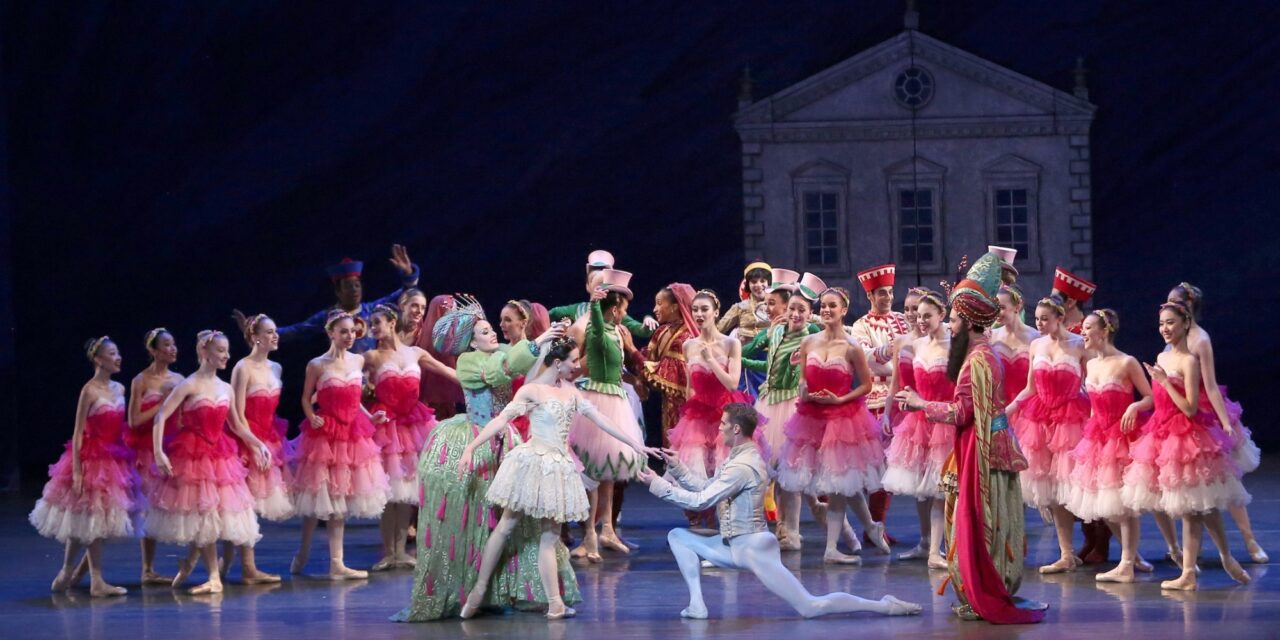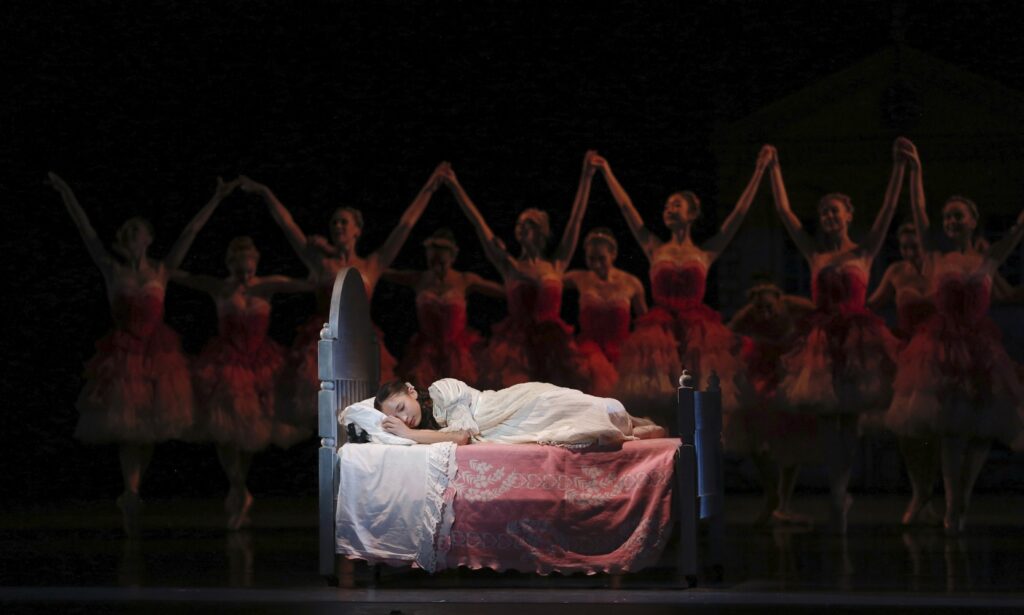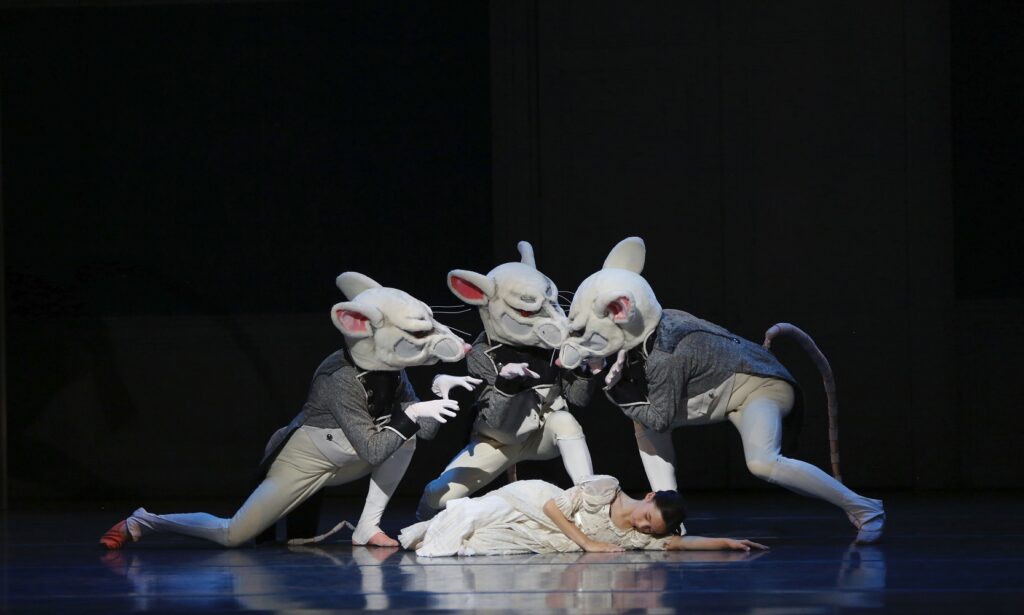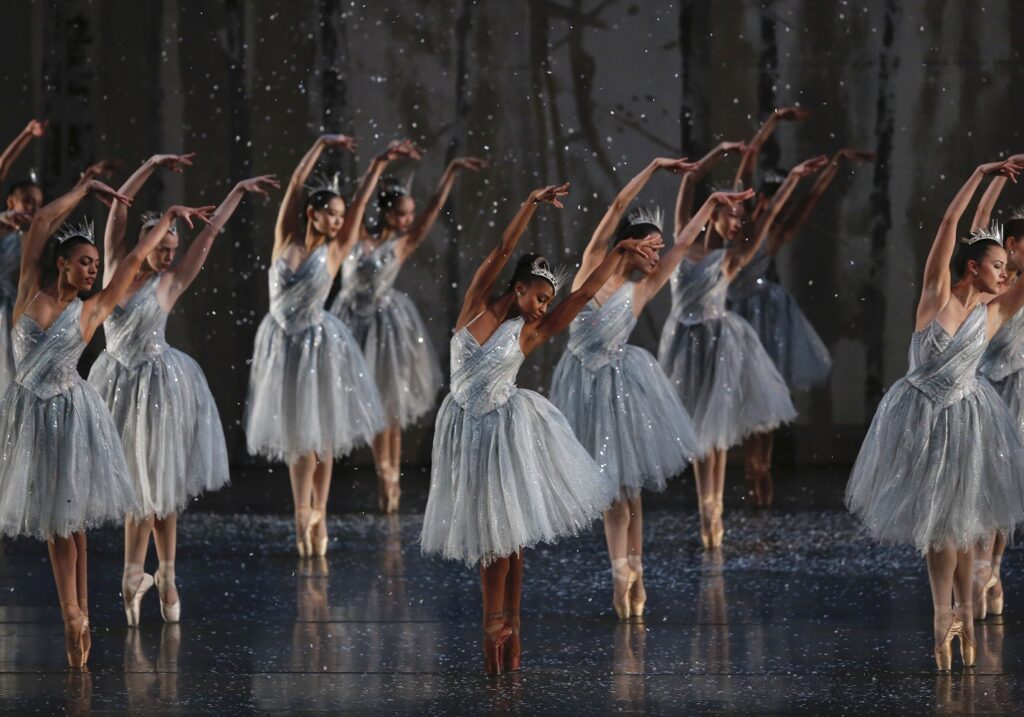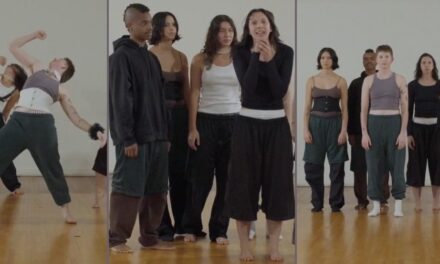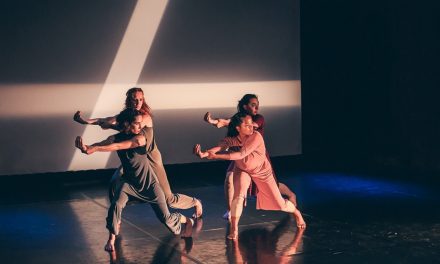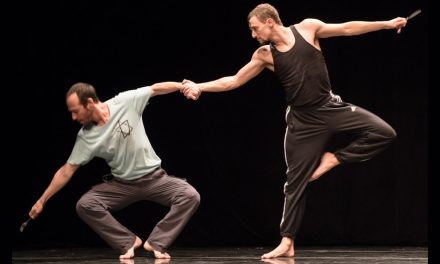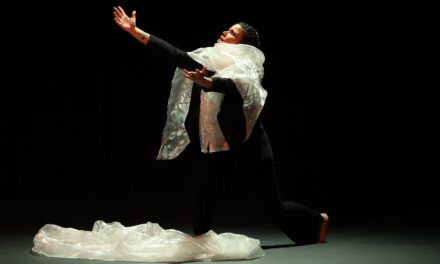This production is a feast for the senses and a family entertainment of the highest order. Sets and Costumes by Richard Hudson with associate designers Justin Arienti and Mauricio Elorriaga are fantastic and are the glue that holds this entire production together. From heavily altered perspective to three-dimensional detailed drops the scenery is stunning and somehow manages to direct focus to what is happening onstage. The dioramas produced are worth gazing at without anyone in particular inhabiting them. When filled with costumes and the bodies which animate them, the entire scene comes alive with color and splendor. Lighting by Jennifer Tipton accents the colorful costumes and delineates the shapes and shadows quite well.
This version of The Nutcracker begins in the kitchen as the Stahlbaum Family are preparing for their Christmas Party. We see the cooks and housekeepers all busily at work as Clara and Fritz come in excited for the evening to be underway. The kitchen clears as everyone moves to the parlor to greet the guests and it is here that we see a lone mouse (Kotaro Kimura) enter to reap the benefits of a recently emptied pot. Clara sees the little creature and this foreshadowing neatly sows the seeds of what is to come, deftly done.
The party scene unfolds in its usual festive manner with adults moving children here and there, interrupting their play when necessary, usually when the boys raid the girls calm circle. It is Dickens inverted to the enjoyment of children. The children have more to do in this Nutcracker, pleading with adults and dancing with their gifts. Drosselmeyer (Duncan Lyle) magically shows up and produces four life-sized dolls for the entertainment of all. Again, the dolls’ costumes are meticulous and vibrant. The Columbine (Rachel Richardson) and Harlequin (Elwince Magbitang) costumes were all black and white and worthy of Jean Cocteau while the Recruit (Carlos Gonzalez) and Canteen Keeper (Anabel Katsnelson) costumes looked as if they stepped out of a Russian Marketplace in ‘Petrushka.’ When Clara becomes sad that she cannot play with the dolls, Drosselmeyer produces a Nutcracker doll for her alone. In this he instigates her fantasy of growth and maturity.
The battle scene had all the requisite mice and soldiers skirmishing. All was set against a beautiful backdrop in forced perspective of a huge chair with Clara sitting on top viewing the battle. Her shoe-throwing in culmination of the fight was heroic enough having to hit the Mouse King from half-a-mile away with limited vision. She overcomes her fear of the Mouse King (Cy Doherty) and finds it within her power to help the Nutcracker doll.
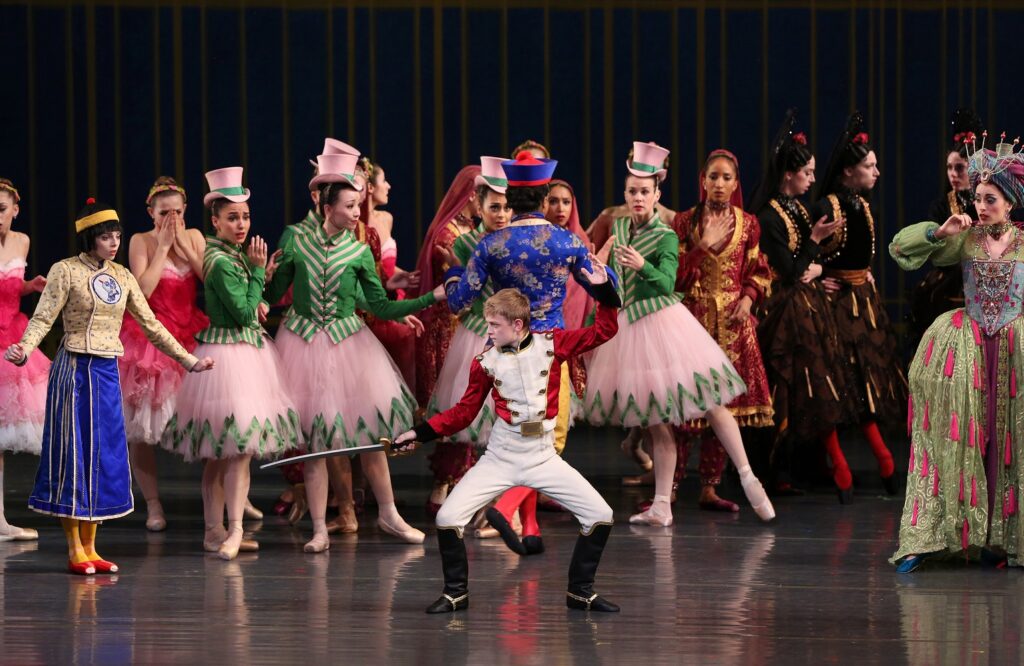
ABT – Sawyer Sublette (Nutcracker Boy) in Alexei Ratmansky’s ‘The Nutcracker’ – Photo by Marty Sohl.
What was evident throughout the show was the psychological underpinnings of Clara’s point of view and her child’s eye perspective of events and personages illuminating her outrageous Uncle Drosselmeyer and his crazy mechanical dolls, with the mice from the kitchen, commingled with a desire or urge to grow up and be counted, be seen, be adored. Every scene led inexorably to the conclusion where she dances, having been transformed into a princess (Christine Shevchenko), with her Nutcracker doll, having been transformed into a prince (Thomas Forster). Clara was ably portrayed by Sakura Kimura who kept our attention through her sense of wonder at every turn.
After the defeat of the Mouse King, Clara and her Nutcracker Prince (Carson Triplett) face a delightful snowfall which transforms into a trial of frost until they are rescued by Drosselmeyer and brought to the wondrous land of the sweets. Here they are celebrated for their courage and strength by dancers from around the globe. The Spanish Dancers were a high point in their effect and delivery. Their costumes were fantastic and served to showcase the clean lines of their choreography. They were Paulina Waski, Jarod Curley, Lauren Bonfiglio, Luis Ribagorda, Courtney Shealy and Joao Menegussi. The Arabians had fun pushing each other out of the way in order to be the favored wife of the clean-shaven Roman Zhurbin. The Chinese duet was dutifully playful with Anabel Katsnelson and Elwince Magbitang. The Russian dance was gregarious enough between three young men reminiscent of the three sailors from “On the Town.” They were Joseph Markey, Duncan McIlwaine and Jake Roxander. Mother Ginger came and went via Tyler Maloney with a gang of little ones in tow. The Polinchinelles had elegant gear along the lines of Empress Sisi in her riding costume, their top hats neatly complimenting the pointe work below.
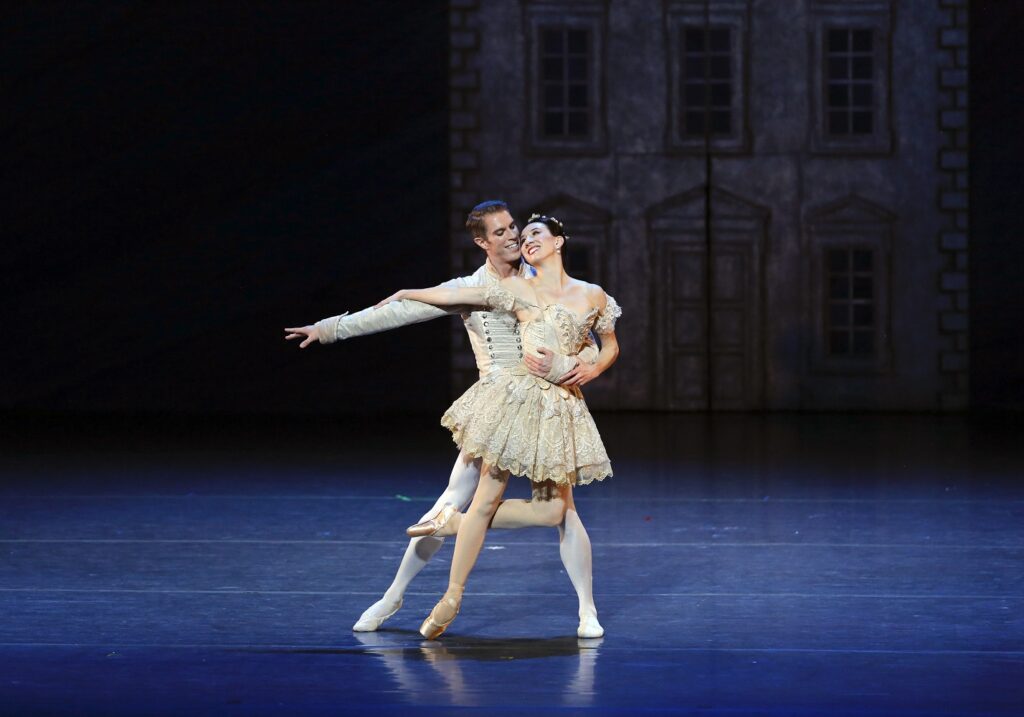
ABT – Isabella Boylston (Clara, the Princess) and James Whiteside (Nutcracker, the Prince) in Alexei Ratmansky’s ‘The Nutcracker’ – Photo by Marty Sohl.
The Waltz of the Flowers enjoyed the addition of four Bees – Andrii Ishchuk, Takumi Miyake, Andrew Robare, and Nathan Vendt who partnered and attended all of the flowers onstage. It was an abstruse choreographic touch for the children in the audience, but perhaps better understood by any rogue botanist who happened to be present. They were enterprising and happy in their endeavors I must say. And the Grand Pas was beautiful and expertly danced by Shevchenko and Forster. All was mannered and precise.
There were moments during the show when I felt the choreography by Alexei Ratmansky took precedence over the music. That is to say that some of the steps took demanding technical skill which did not follow the melody or scope of the music. The dancers were all capable of handling the technical difficulty, but it seemed an effort to impress with steps when simply matching the soaring musicality of Tchaikovsky would have sufficed quite nicely. This was true throughout the ballet and more pronounced in the Land of the Sugar Plum Fairy variations. This was admittedly a small concern when compared with the overall magnificence of the entire production.
ABT’s The Nutcracker continues through Sunday, December 22 at The Segerstrom Center. For more information and to purchase tickets, please click HERE.
To learn more about American Ballet Theatre, please visit their website.
Written by Brian Fretté for LA Dance Chronicle.
Featured image: ABT in Alexei Ratmansky’s The Nutcracker – Photo by Marty Sohl.

